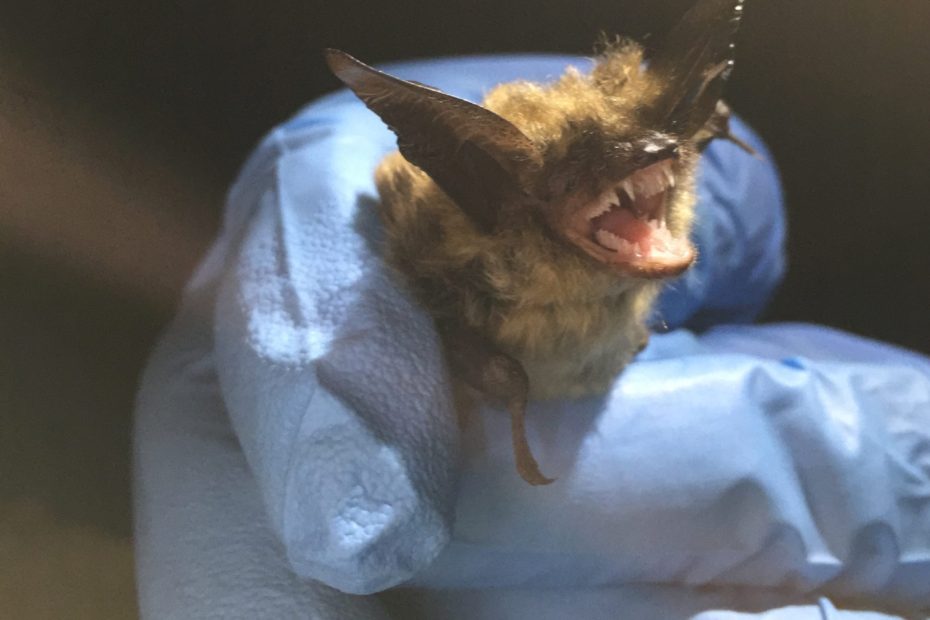“Everybody, yeah, Flap those wings, yeah, Everybody, yeah, Flap those wings, yeah, Myotis bats are back, alright!” (sung to the tune of “Everybody” by Backstreet Boys).
Although spring officially began a few weeks ago, it seems the local Myotis species have just noticed the change. At the very least, they have definitely swung into town in full foraging force. Last night was the first night of our spring migration netting efforts as we try to track down the silver haired and hoary bats as they move through the redwoods to their summer ground (wherever those happen to be). This means April and May will be filled with lots of netting nights as we ramp up our efforts and try to maximize our chances of data collection and potential recapture data.
We opened our nets right at sunset and almost instantly began catching bats, sometimes two or three in a net at a time. Even more bats could be seen flying around, particularly along the edge of the water, expertly maneuvering their way around, over and past our nets.

We caught the usual suspects (California myotis, Yuma myotis, silver haired bats and hoary bats). However, we were pleasantly surprised with the capture of two species we have not seen in the area since last summer.
We caught three fringed myotis (Myotis thysanodes), two of which were females. We have caught this species at this particular site in the past, but not since about July or August. Fringed myotis are distinguished from other small brown bat species in the area by their slightly longer eared and the distinctive hairy “fringe” along the edge of their uropatagium (skin between their legs and tail). Other bats, such as long-legged myotis (Myotis volans) will sometimes have a little bit of a fringe, but not nearly as thick as the fringed myotis.


I was pleasantly surprised by the first bat that was taken out of the net, a long-eared myotis (Myotis evotis). This was my first time encountering this species in the redwood forest, though we caught several of them last summer at Lassen National Park. As you might guess, long-eared myotis have long ears (more than 20mm in length)!

Once we have a bat in hand, we make several important observation and measurements. Some measurements, such as ear length and presence of a keel (flap of skin at the bat’s ankle) help us identify species. We also measure forearm length using calipers. This gives a general sense of a bat’s size and can also help with species identification in some instances. We record the sex of a bat and also the reproductive status. In males, reproductive status is determined by looking for the obvious presence of testes (which will bulge around the penis) and the fill level of the epididymis (the tubes that deliver sperm from the testes to the penis). This observations provide information about the reproductive readiness of an individual. If the bat is actively producing sperm and in mating condition, we expect the epididymis to be full and the testes to be easily visible. In females, we look at the condition of the nipples, which can tell us if a bat has recently nursed young. During the summer, lactating females are easily identified by the tiny bit of milk that is present. Females that have never reproduced will have very small, almost undetectable nipples. Age of a bat (adult or juvenile) is determined by looking at the joints of the bat fingers (wings). In juveniles, there is a visible gap or “window” in the joints where the bone has not finished growing together. In adults, these joints are more rounded and knobby, lacking that “window”. Finally, we take a weight measurement, which can give us insight into the bat’s condition. If a bat is nice and heavy, then chances are he/she has been successful foraging. Bats are generally heavier in the summer, after they have had time to replenish fat stores used during winter migration or hibernation.


I made this short video to show you more of how we take measurements on the bats: Processing a Live Bat.
All of this data helps us gain a better understanding of the diversity and abundance of bat species in an area and insight into how they might be using the habitat (such as a migration corridor or summer maternity roosting). It is going to be a busy spring and I can’t wait to see what we catch next time!

